Technical Paper on Sustainable Construction and Green Building Trends
VerifiedAdded on 2023/06/15
|31
|11715
|245
Report
AI Summary
This report provides an overview of sustainable construction, green building, and green design, highlighting practices adopted by private institutes, government, and non-profit organizations. It focuses on key areas such as sustainable building performance, technology innovation, sustainability assessment, and government policies. The report emphasizes the link between sustainable construction and energy/material conservation, critically analyzing existing research. It discusses how construction impacts the environment and the need for sustainable practices, reviewing trends, strategies, and developments in sustainable construction and green building, aiming to promote eco-friendly and resource-efficient building practices.

Construction ManagementUser
Paraphrase This Document
Need a fresh take? Get an instant paraphrase of this document with our AI Paraphraser
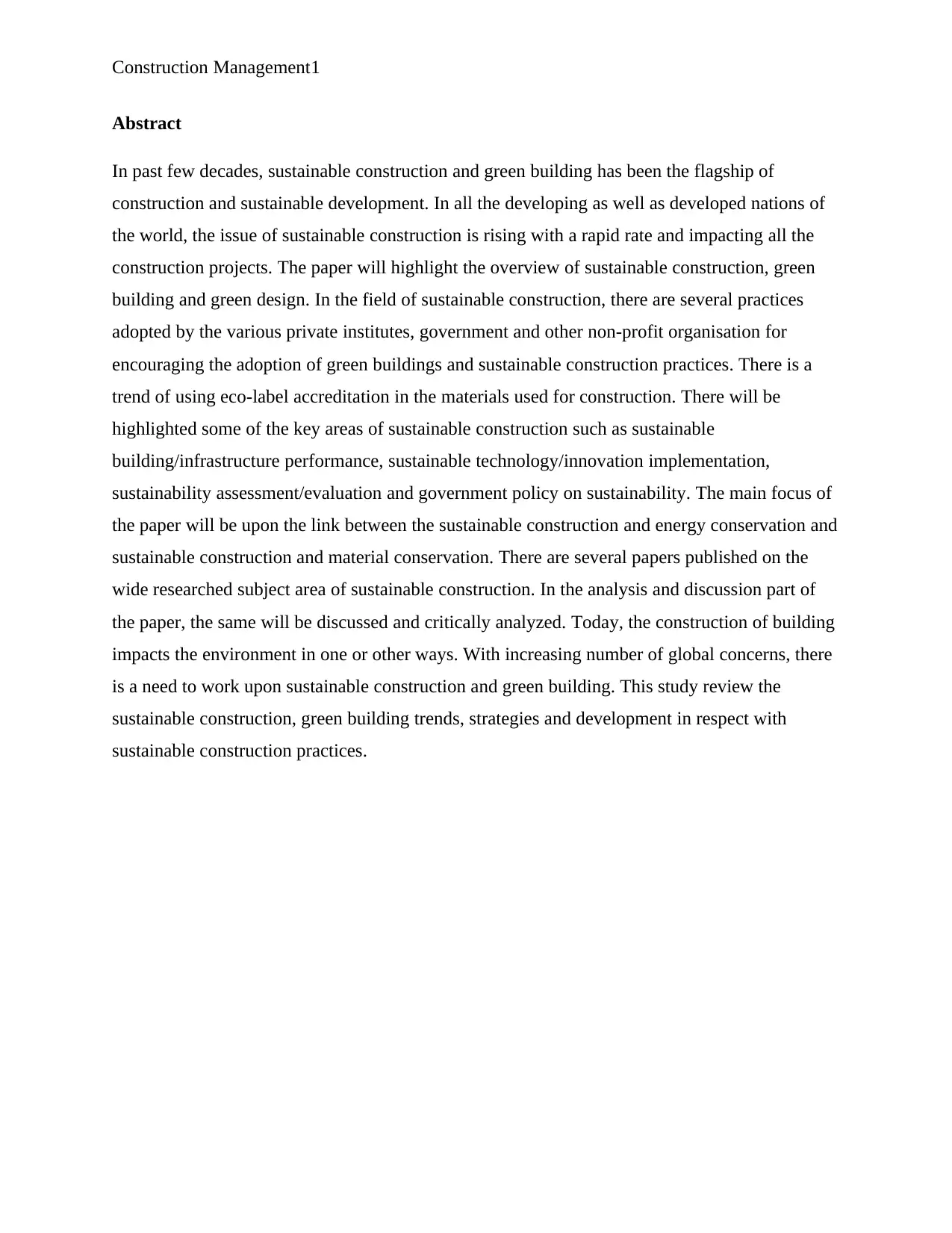
Construction Management1
Abstract
In past few decades, sustainable construction and green building has been the flagship of
construction and sustainable development. In all the developing as well as developed nations of
the world, the issue of sustainable construction is rising with a rapid rate and impacting all the
construction projects. The paper will highlight the overview of sustainable construction, green
building and green design. In the field of sustainable construction, there are several practices
adopted by the various private institutes, government and other non-profit organisation for
encouraging the adoption of green buildings and sustainable construction practices. There is a
trend of using eco-label accreditation in the materials used for construction. There will be
highlighted some of the key areas of sustainable construction such as sustainable
building/infrastructure performance, sustainable technology/innovation implementation,
sustainability assessment/evaluation and government policy on sustainability. The main focus of
the paper will be upon the link between the sustainable construction and energy conservation and
sustainable construction and material conservation. There are several papers published on the
wide researched subject area of sustainable construction. In the analysis and discussion part of
the paper, the same will be discussed and critically analyzed. Today, the construction of building
impacts the environment in one or other ways. With increasing number of global concerns, there
is a need to work upon sustainable construction and green building. This study review the
sustainable construction, green building trends, strategies and development in respect with
sustainable construction practices.
Abstract
In past few decades, sustainable construction and green building has been the flagship of
construction and sustainable development. In all the developing as well as developed nations of
the world, the issue of sustainable construction is rising with a rapid rate and impacting all the
construction projects. The paper will highlight the overview of sustainable construction, green
building and green design. In the field of sustainable construction, there are several practices
adopted by the various private institutes, government and other non-profit organisation for
encouraging the adoption of green buildings and sustainable construction practices. There is a
trend of using eco-label accreditation in the materials used for construction. There will be
highlighted some of the key areas of sustainable construction such as sustainable
building/infrastructure performance, sustainable technology/innovation implementation,
sustainability assessment/evaluation and government policy on sustainability. The main focus of
the paper will be upon the link between the sustainable construction and energy conservation and
sustainable construction and material conservation. There are several papers published on the
wide researched subject area of sustainable construction. In the analysis and discussion part of
the paper, the same will be discussed and critically analyzed. Today, the construction of building
impacts the environment in one or other ways. With increasing number of global concerns, there
is a need to work upon sustainable construction and green building. This study review the
sustainable construction, green building trends, strategies and development in respect with
sustainable construction practices.
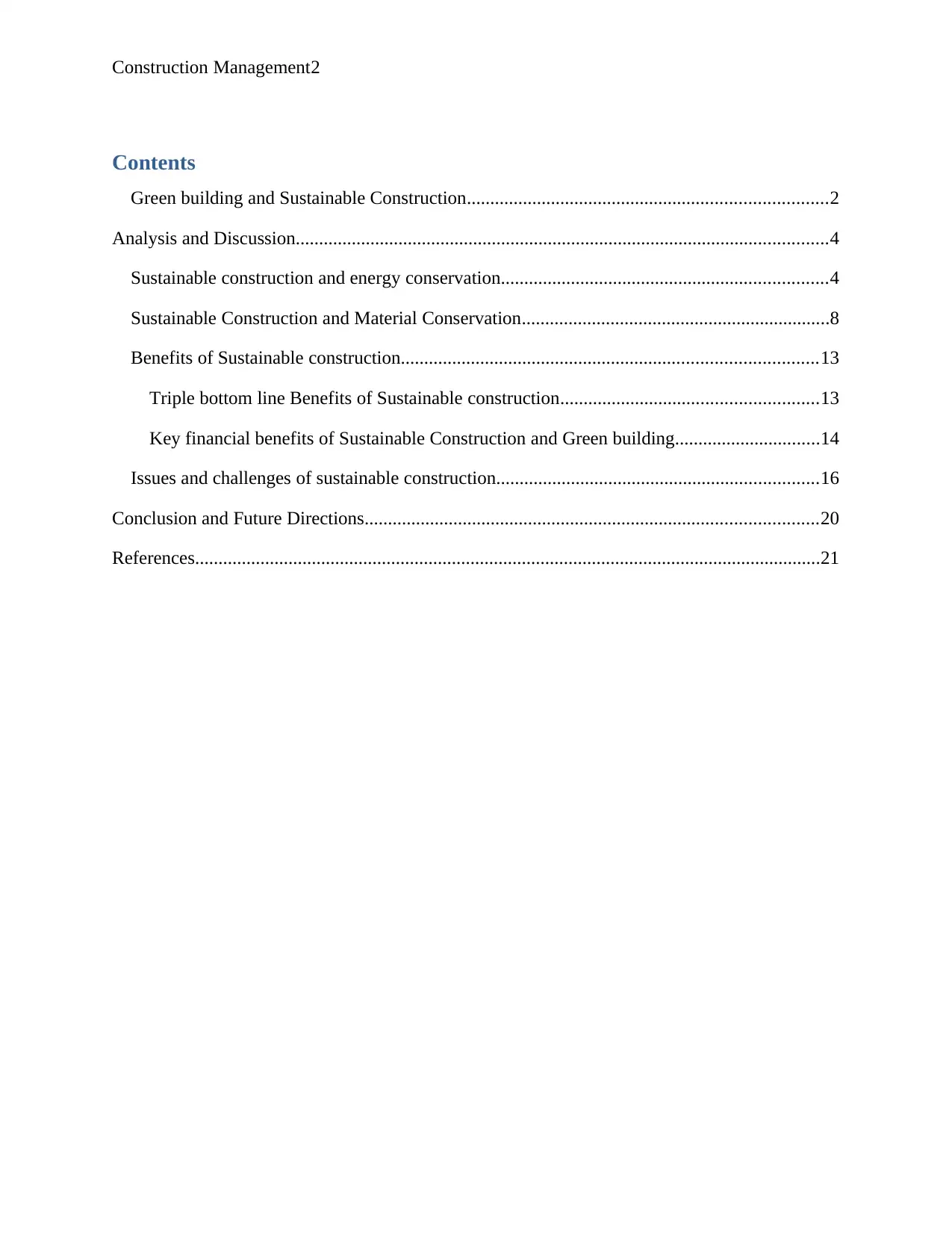
Construction Management2
Contents
Green building and Sustainable Construction.............................................................................2
Analysis and Discussion..................................................................................................................4
Sustainable construction and energy conservation......................................................................4
Sustainable Construction and Material Conservation..................................................................8
Benefits of Sustainable construction.........................................................................................13
Triple bottom line Benefits of Sustainable construction.......................................................13
Key financial benefits of Sustainable Construction and Green building...............................14
Issues and challenges of sustainable construction.....................................................................16
Conclusion and Future Directions.................................................................................................20
References......................................................................................................................................21
Contents
Green building and Sustainable Construction.............................................................................2
Analysis and Discussion..................................................................................................................4
Sustainable construction and energy conservation......................................................................4
Sustainable Construction and Material Conservation..................................................................8
Benefits of Sustainable construction.........................................................................................13
Triple bottom line Benefits of Sustainable construction.......................................................13
Key financial benefits of Sustainable Construction and Green building...............................14
Issues and challenges of sustainable construction.....................................................................16
Conclusion and Future Directions.................................................................................................20
References......................................................................................................................................21
⊘ This is a preview!⊘
Do you want full access?
Subscribe today to unlock all pages.

Trusted by 1+ million students worldwide
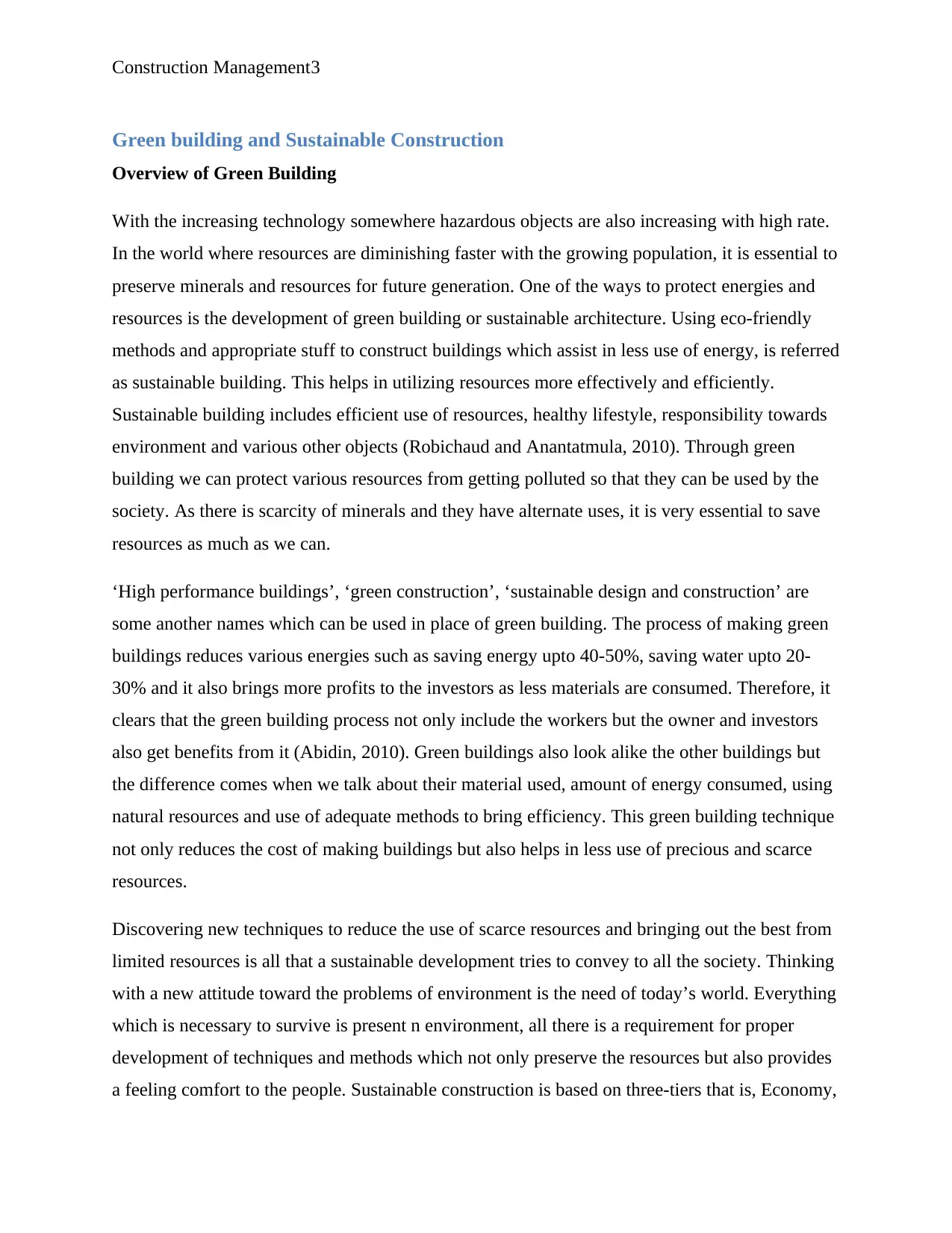
Construction Management3
Green building and Sustainable Construction
Overview of Green Building
With the increasing technology somewhere hazardous objects are also increasing with high rate.
In the world where resources are diminishing faster with the growing population, it is essential to
preserve minerals and resources for future generation. One of the ways to protect energies and
resources is the development of green building or sustainable architecture. Using eco-friendly
methods and appropriate stuff to construct buildings which assist in less use of energy, is referred
as sustainable building. This helps in utilizing resources more effectively and efficiently.
Sustainable building includes efficient use of resources, healthy lifestyle, responsibility towards
environment and various other objects (Robichaud and Anantatmula, 2010). Through green
building we can protect various resources from getting polluted so that they can be used by the
society. As there is scarcity of minerals and they have alternate uses, it is very essential to save
resources as much as we can.
‘High performance buildings’, ‘green construction’, ‘sustainable design and construction’ are
some another names which can be used in place of green building. The process of making green
buildings reduces various energies such as saving energy upto 40-50%, saving water upto 20-
30% and it also brings more profits to the investors as less materials are consumed. Therefore, it
clears that the green building process not only include the workers but the owner and investors
also get benefits from it (Abidin, 2010). Green buildings also look alike the other buildings but
the difference comes when we talk about their material used, amount of energy consumed, using
natural resources and use of adequate methods to bring efficiency. This green building technique
not only reduces the cost of making buildings but also helps in less use of precious and scarce
resources.
Discovering new techniques to reduce the use of scarce resources and bringing out the best from
limited resources is all that a sustainable development tries to convey to all the society. Thinking
with a new attitude toward the problems of environment is the need of today’s world. Everything
which is necessary to survive is present n environment, all there is a requirement for proper
development of techniques and methods which not only preserve the resources but also provides
a feeling comfort to the people. Sustainable construction is based on three-tiers that is, Economy,
Green building and Sustainable Construction
Overview of Green Building
With the increasing technology somewhere hazardous objects are also increasing with high rate.
In the world where resources are diminishing faster with the growing population, it is essential to
preserve minerals and resources for future generation. One of the ways to protect energies and
resources is the development of green building or sustainable architecture. Using eco-friendly
methods and appropriate stuff to construct buildings which assist in less use of energy, is referred
as sustainable building. This helps in utilizing resources more effectively and efficiently.
Sustainable building includes efficient use of resources, healthy lifestyle, responsibility towards
environment and various other objects (Robichaud and Anantatmula, 2010). Through green
building we can protect various resources from getting polluted so that they can be used by the
society. As there is scarcity of minerals and they have alternate uses, it is very essential to save
resources as much as we can.
‘High performance buildings’, ‘green construction’, ‘sustainable design and construction’ are
some another names which can be used in place of green building. The process of making green
buildings reduces various energies such as saving energy upto 40-50%, saving water upto 20-
30% and it also brings more profits to the investors as less materials are consumed. Therefore, it
clears that the green building process not only include the workers but the owner and investors
also get benefits from it (Abidin, 2010). Green buildings also look alike the other buildings but
the difference comes when we talk about their material used, amount of energy consumed, using
natural resources and use of adequate methods to bring efficiency. This green building technique
not only reduces the cost of making buildings but also helps in less use of precious and scarce
resources.
Discovering new techniques to reduce the use of scarce resources and bringing out the best from
limited resources is all that a sustainable development tries to convey to all the society. Thinking
with a new attitude toward the problems of environment is the need of today’s world. Everything
which is necessary to survive is present n environment, all there is a requirement for proper
development of techniques and methods which not only preserve the resources but also provides
a feeling comfort to the people. Sustainable construction is based on three-tiers that is, Economy,
Paraphrase This Document
Need a fresh take? Get an instant paraphrase of this document with our AI Paraphraser
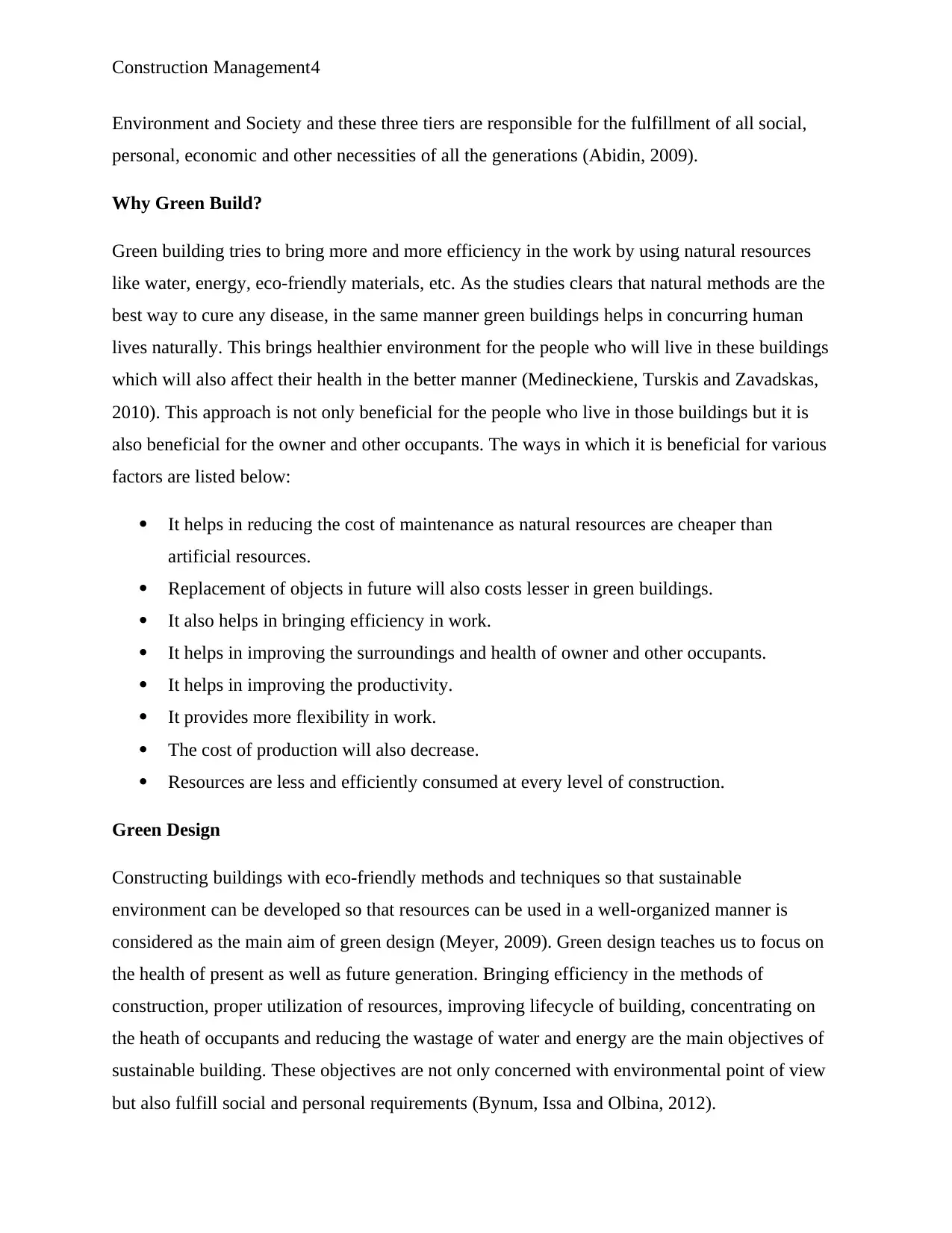
Construction Management4
Environment and Society and these three tiers are responsible for the fulfillment of all social,
personal, economic and other necessities of all the generations (Abidin, 2009).
Why Green Build?
Green building tries to bring more and more efficiency in the work by using natural resources
like water, energy, eco-friendly materials, etc. As the studies clears that natural methods are the
best way to cure any disease, in the same manner green buildings helps in concurring human
lives naturally. This brings healthier environment for the people who will live in these buildings
which will also affect their health in the better manner (Medineckiene, Turskis and Zavadskas,
2010). This approach is not only beneficial for the people who live in those buildings but it is
also beneficial for the owner and other occupants. The ways in which it is beneficial for various
factors are listed below:
It helps in reducing the cost of maintenance as natural resources are cheaper than
artificial resources.
Replacement of objects in future will also costs lesser in green buildings.
It also helps in bringing efficiency in work.
It helps in improving the surroundings and health of owner and other occupants.
It helps in improving the productivity.
It provides more flexibility in work.
The cost of production will also decrease.
Resources are less and efficiently consumed at every level of construction.
Green Design
Constructing buildings with eco-friendly methods and techniques so that sustainable
environment can be developed so that resources can be used in a well-organized manner is
considered as the main aim of green design (Meyer, 2009). Green design teaches us to focus on
the health of present as well as future generation. Bringing efficiency in the methods of
construction, proper utilization of resources, improving lifecycle of building, concentrating on
the heath of occupants and reducing the wastage of water and energy are the main objectives of
sustainable building. These objectives are not only concerned with environmental point of view
but also fulfill social and personal requirements (Bynum, Issa and Olbina, 2012).
Environment and Society and these three tiers are responsible for the fulfillment of all social,
personal, economic and other necessities of all the generations (Abidin, 2009).
Why Green Build?
Green building tries to bring more and more efficiency in the work by using natural resources
like water, energy, eco-friendly materials, etc. As the studies clears that natural methods are the
best way to cure any disease, in the same manner green buildings helps in concurring human
lives naturally. This brings healthier environment for the people who will live in these buildings
which will also affect their health in the better manner (Medineckiene, Turskis and Zavadskas,
2010). This approach is not only beneficial for the people who live in those buildings but it is
also beneficial for the owner and other occupants. The ways in which it is beneficial for various
factors are listed below:
It helps in reducing the cost of maintenance as natural resources are cheaper than
artificial resources.
Replacement of objects in future will also costs lesser in green buildings.
It also helps in bringing efficiency in work.
It helps in improving the surroundings and health of owner and other occupants.
It helps in improving the productivity.
It provides more flexibility in work.
The cost of production will also decrease.
Resources are less and efficiently consumed at every level of construction.
Green Design
Constructing buildings with eco-friendly methods and techniques so that sustainable
environment can be developed so that resources can be used in a well-organized manner is
considered as the main aim of green design (Meyer, 2009). Green design teaches us to focus on
the health of present as well as future generation. Bringing efficiency in the methods of
construction, proper utilization of resources, improving lifecycle of building, concentrating on
the heath of occupants and reducing the wastage of water and energy are the main objectives of
sustainable building. These objectives are not only concerned with environmental point of view
but also fulfill social and personal requirements (Bynum, Issa and Olbina, 2012).
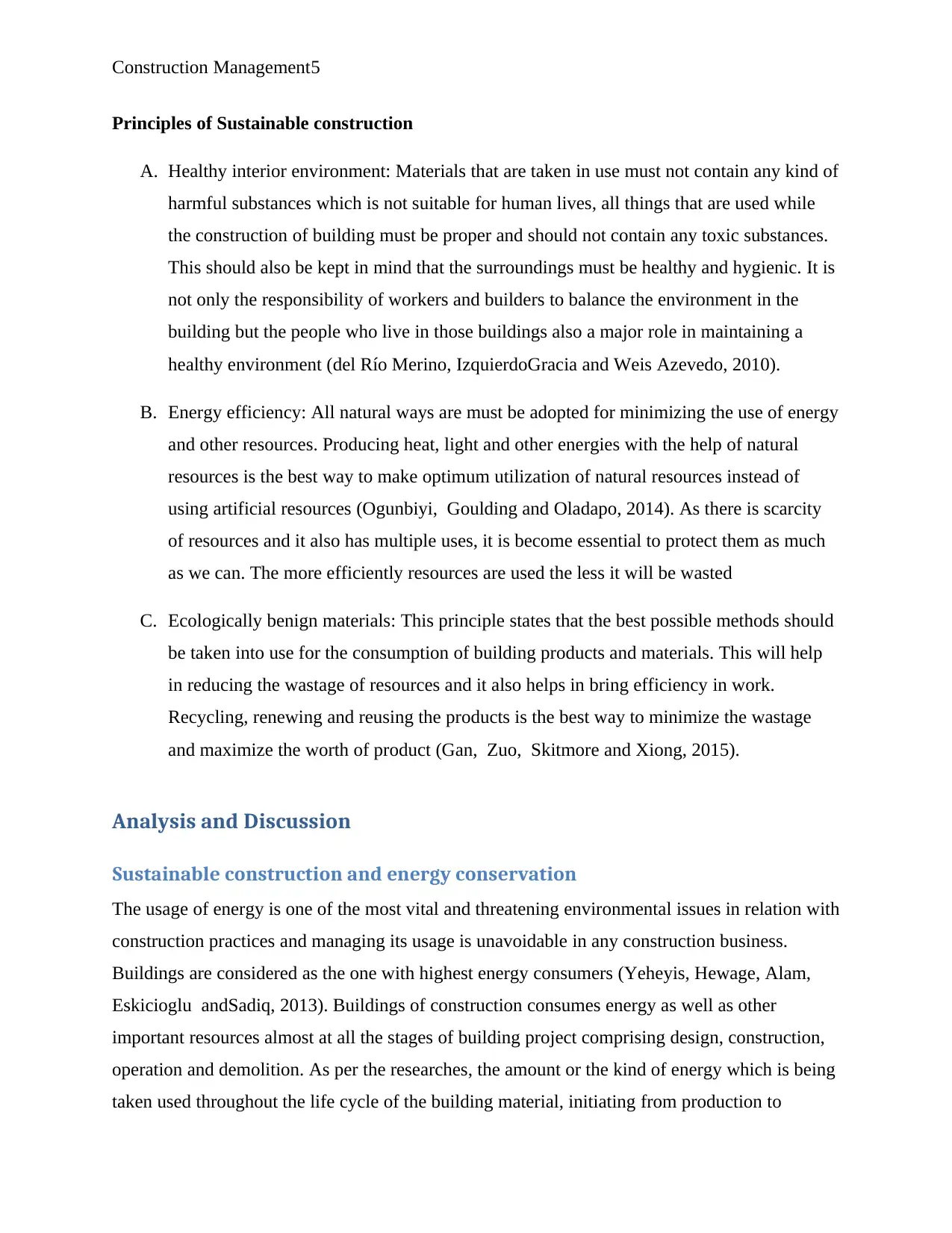
Construction Management5
Principles of Sustainable construction
A. Healthy interior environment: Materials that are taken in use must not contain any kind of
harmful substances which is not suitable for human lives, all things that are used while
the construction of building must be proper and should not contain any toxic substances.
This should also be kept in mind that the surroundings must be healthy and hygienic. It is
not only the responsibility of workers and builders to balance the environment in the
building but the people who live in those buildings also a major role in maintaining a
healthy environment (del Río Merino, IzquierdoGracia and Weis Azevedo, 2010).
B. Energy efficiency: All natural ways are must be adopted for minimizing the use of energy
and other resources. Producing heat, light and other energies with the help of natural
resources is the best way to make optimum utilization of natural resources instead of
using artificial resources (Ogunbiyi, Goulding and Oladapo, 2014). As there is scarcity
of resources and it also has multiple uses, it is become essential to protect them as much
as we can. The more efficiently resources are used the less it will be wasted
C. Ecologically benign materials: This principle states that the best possible methods should
be taken into use for the consumption of building products and materials. This will help
in reducing the wastage of resources and it also helps in bring efficiency in work.
Recycling, renewing and reusing the products is the best way to minimize the wastage
and maximize the worth of product (Gan, Zuo, Skitmore and Xiong, 2015).
Analysis and Discussion
Sustainable construction and energy conservation
The usage of energy is one of the most vital and threatening environmental issues in relation with
construction practices and managing its usage is unavoidable in any construction business.
Buildings are considered as the one with highest energy consumers (Yeheyis, Hewage, Alam,
Eskicioglu andSadiq, 2013). Buildings of construction consumes energy as well as other
important resources almost at all the stages of building project comprising design, construction,
operation and demolition. As per the researches, the amount or the kind of energy which is being
taken used throughout the life cycle of the building material, initiating from production to
Principles of Sustainable construction
A. Healthy interior environment: Materials that are taken in use must not contain any kind of
harmful substances which is not suitable for human lives, all things that are used while
the construction of building must be proper and should not contain any toxic substances.
This should also be kept in mind that the surroundings must be healthy and hygienic. It is
not only the responsibility of workers and builders to balance the environment in the
building but the people who live in those buildings also a major role in maintaining a
healthy environment (del Río Merino, IzquierdoGracia and Weis Azevedo, 2010).
B. Energy efficiency: All natural ways are must be adopted for minimizing the use of energy
and other resources. Producing heat, light and other energies with the help of natural
resources is the best way to make optimum utilization of natural resources instead of
using artificial resources (Ogunbiyi, Goulding and Oladapo, 2014). As there is scarcity
of resources and it also has multiple uses, it is become essential to protect them as much
as we can. The more efficiently resources are used the less it will be wasted
C. Ecologically benign materials: This principle states that the best possible methods should
be taken into use for the consumption of building products and materials. This will help
in reducing the wastage of resources and it also helps in bring efficiency in work.
Recycling, renewing and reusing the products is the best way to minimize the wastage
and maximize the worth of product (Gan, Zuo, Skitmore and Xiong, 2015).
Analysis and Discussion
Sustainable construction and energy conservation
The usage of energy is one of the most vital and threatening environmental issues in relation with
construction practices and managing its usage is unavoidable in any construction business.
Buildings are considered as the one with highest energy consumers (Yeheyis, Hewage, Alam,
Eskicioglu andSadiq, 2013). Buildings of construction consumes energy as well as other
important resources almost at all the stages of building project comprising design, construction,
operation and demolition. As per the researches, the amount or the kind of energy which is being
taken used throughout the life cycle of the building material, initiating from production to
⊘ This is a preview!⊘
Do you want full access?
Subscribe today to unlock all pages.

Trusted by 1+ million students worldwide
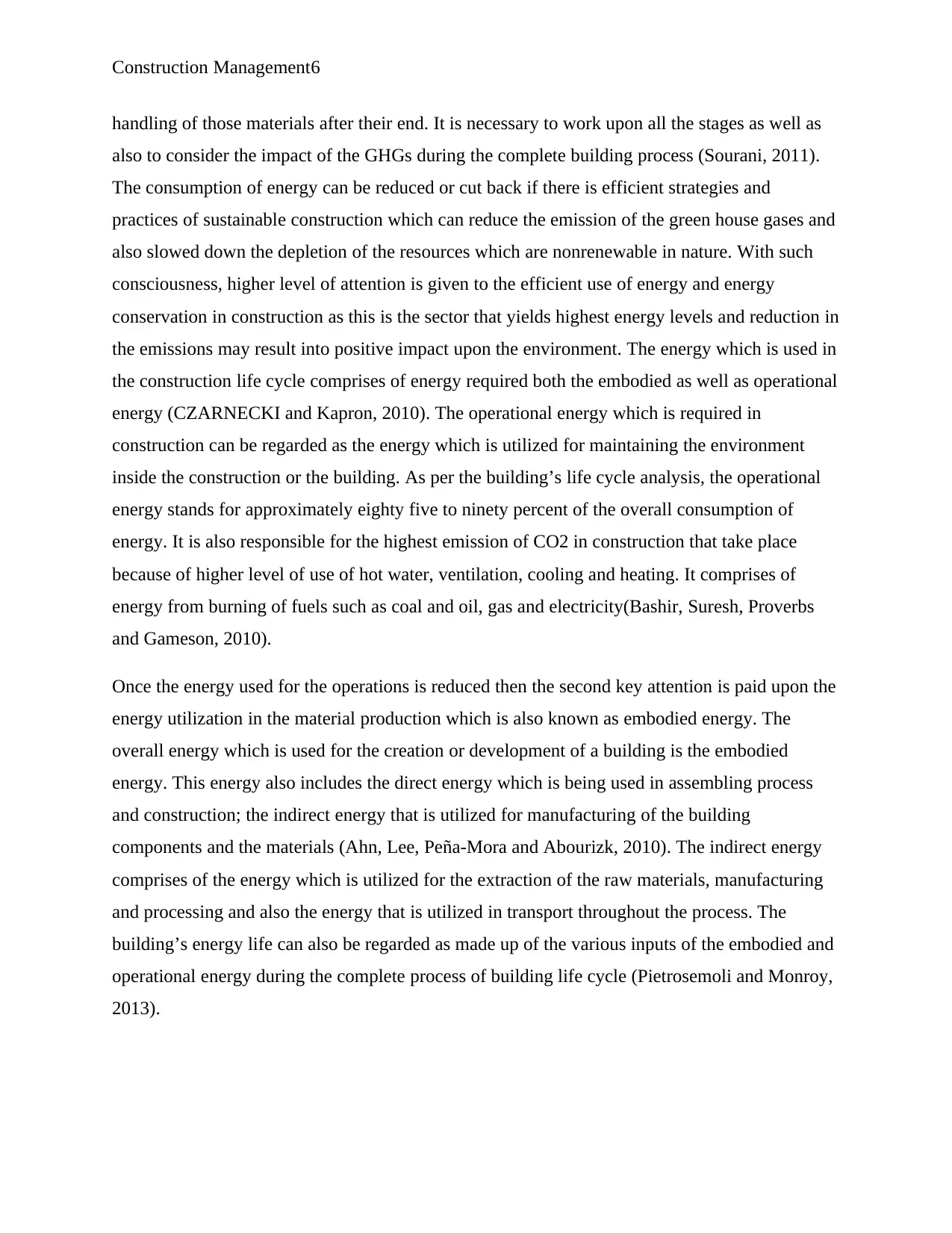
Construction Management6
handling of those materials after their end. It is necessary to work upon all the stages as well as
also to consider the impact of the GHGs during the complete building process (Sourani, 2011).
The consumption of energy can be reduced or cut back if there is efficient strategies and
practices of sustainable construction which can reduce the emission of the green house gases and
also slowed down the depletion of the resources which are nonrenewable in nature. With such
consciousness, higher level of attention is given to the efficient use of energy and energy
conservation in construction as this is the sector that yields highest energy levels and reduction in
the emissions may result into positive impact upon the environment. The energy which is used in
the construction life cycle comprises of energy required both the embodied as well as operational
energy (CZARNECKI and Kapron, 2010). The operational energy which is required in
construction can be regarded as the energy which is utilized for maintaining the environment
inside the construction or the building. As per the building’s life cycle analysis, the operational
energy stands for approximately eighty five to ninety percent of the overall consumption of
energy. It is also responsible for the highest emission of CO2 in construction that take place
because of higher level of use of hot water, ventilation, cooling and heating. It comprises of
energy from burning of fuels such as coal and oil, gas and electricity(Bashir, Suresh, Proverbs
and Gameson, 2010).
Once the energy used for the operations is reduced then the second key attention is paid upon the
energy utilization in the material production which is also known as embodied energy. The
overall energy which is used for the creation or development of a building is the embodied
energy. This energy also includes the direct energy which is being used in assembling process
and construction; the indirect energy that is utilized for manufacturing of the building
components and the materials (Ahn, Lee, Peña-Mora and Abourizk, 2010). The indirect energy
comprises of the energy which is utilized for the extraction of the raw materials, manufacturing
and processing and also the energy that is utilized in transport throughout the process. The
building’s energy life can also be regarded as made up of the various inputs of the embodied and
operational energy during the complete process of building life cycle (Pietrosemoli and Monroy,
2013).
handling of those materials after their end. It is necessary to work upon all the stages as well as
also to consider the impact of the GHGs during the complete building process (Sourani, 2011).
The consumption of energy can be reduced or cut back if there is efficient strategies and
practices of sustainable construction which can reduce the emission of the green house gases and
also slowed down the depletion of the resources which are nonrenewable in nature. With such
consciousness, higher level of attention is given to the efficient use of energy and energy
conservation in construction as this is the sector that yields highest energy levels and reduction in
the emissions may result into positive impact upon the environment. The energy which is used in
the construction life cycle comprises of energy required both the embodied as well as operational
energy (CZARNECKI and Kapron, 2010). The operational energy which is required in
construction can be regarded as the energy which is utilized for maintaining the environment
inside the construction or the building. As per the building’s life cycle analysis, the operational
energy stands for approximately eighty five to ninety percent of the overall consumption of
energy. It is also responsible for the highest emission of CO2 in construction that take place
because of higher level of use of hot water, ventilation, cooling and heating. It comprises of
energy from burning of fuels such as coal and oil, gas and electricity(Bashir, Suresh, Proverbs
and Gameson, 2010).
Once the energy used for the operations is reduced then the second key attention is paid upon the
energy utilization in the material production which is also known as embodied energy. The
overall energy which is used for the creation or development of a building is the embodied
energy. This energy also includes the direct energy which is being used in assembling process
and construction; the indirect energy that is utilized for manufacturing of the building
components and the materials (Ahn, Lee, Peña-Mora and Abourizk, 2010). The indirect energy
comprises of the energy which is utilized for the extraction of the raw materials, manufacturing
and processing and also the energy that is utilized in transport throughout the process. The
building’s energy life can also be regarded as made up of the various inputs of the embodied and
operational energy during the complete process of building life cycle (Pietrosemoli and Monroy,
2013).
Paraphrase This Document
Need a fresh take? Get an instant paraphrase of this document with our AI Paraphraser
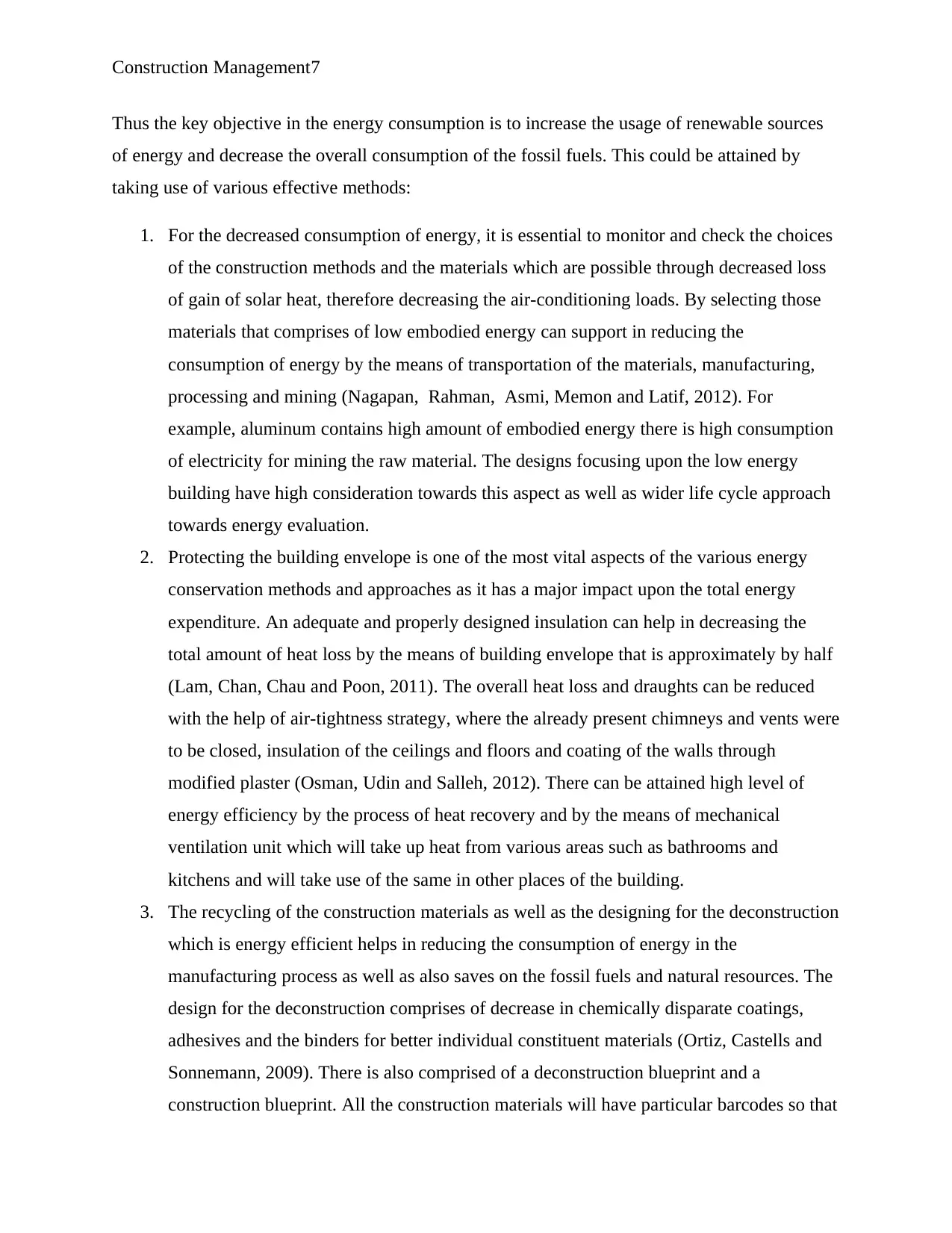
Construction Management7
Thus the key objective in the energy consumption is to increase the usage of renewable sources
of energy and decrease the overall consumption of the fossil fuels. This could be attained by
taking use of various effective methods:
1. For the decreased consumption of energy, it is essential to monitor and check the choices
of the construction methods and the materials which are possible through decreased loss
of gain of solar heat, therefore decreasing the air-conditioning loads. By selecting those
materials that comprises of low embodied energy can support in reducing the
consumption of energy by the means of transportation of the materials, manufacturing,
processing and mining (Nagapan, Rahman, Asmi, Memon and Latif, 2012). For
example, aluminum contains high amount of embodied energy there is high consumption
of electricity for mining the raw material. The designs focusing upon the low energy
building have high consideration towards this aspect as well as wider life cycle approach
towards energy evaluation.
2. Protecting the building envelope is one of the most vital aspects of the various energy
conservation methods and approaches as it has a major impact upon the total energy
expenditure. An adequate and properly designed insulation can help in decreasing the
total amount of heat loss by the means of building envelope that is approximately by half
(Lam, Chan, Chau and Poon, 2011). The overall heat loss and draughts can be reduced
with the help of air-tightness strategy, where the already present chimneys and vents were
to be closed, insulation of the ceilings and floors and coating of the walls through
modified plaster (Osman, Udin and Salleh, 2012). There can be attained high level of
energy efficiency by the process of heat recovery and by the means of mechanical
ventilation unit which will take up heat from various areas such as bathrooms and
kitchens and will take use of the same in other places of the building.
3. The recycling of the construction materials as well as the designing for the deconstruction
which is energy efficient helps in reducing the consumption of energy in the
manufacturing process as well as also saves on the fossil fuels and natural resources. The
design for the deconstruction comprises of decrease in chemically disparate coatings,
adhesives and the binders for better individual constituent materials (Ortiz, Castells and
Sonnemann, 2009). There is also comprised of a deconstruction blueprint and a
construction blueprint. All the construction materials will have particular barcodes so that
Thus the key objective in the energy consumption is to increase the usage of renewable sources
of energy and decrease the overall consumption of the fossil fuels. This could be attained by
taking use of various effective methods:
1. For the decreased consumption of energy, it is essential to monitor and check the choices
of the construction methods and the materials which are possible through decreased loss
of gain of solar heat, therefore decreasing the air-conditioning loads. By selecting those
materials that comprises of low embodied energy can support in reducing the
consumption of energy by the means of transportation of the materials, manufacturing,
processing and mining (Nagapan, Rahman, Asmi, Memon and Latif, 2012). For
example, aluminum contains high amount of embodied energy there is high consumption
of electricity for mining the raw material. The designs focusing upon the low energy
building have high consideration towards this aspect as well as wider life cycle approach
towards energy evaluation.
2. Protecting the building envelope is one of the most vital aspects of the various energy
conservation methods and approaches as it has a major impact upon the total energy
expenditure. An adequate and properly designed insulation can help in decreasing the
total amount of heat loss by the means of building envelope that is approximately by half
(Lam, Chan, Chau and Poon, 2011). The overall heat loss and draughts can be reduced
with the help of air-tightness strategy, where the already present chimneys and vents were
to be closed, insulation of the ceilings and floors and coating of the walls through
modified plaster (Osman, Udin and Salleh, 2012). There can be attained high level of
energy efficiency by the process of heat recovery and by the means of mechanical
ventilation unit which will take up heat from various areas such as bathrooms and
kitchens and will take use of the same in other places of the building.
3. The recycling of the construction materials as well as the designing for the deconstruction
which is energy efficient helps in reducing the consumption of energy in the
manufacturing process as well as also saves on the fossil fuels and natural resources. The
design for the deconstruction comprises of decrease in chemically disparate coatings,
adhesives and the binders for better individual constituent materials (Ortiz, Castells and
Sonnemann, 2009). There is also comprised of a deconstruction blueprint and a
construction blueprint. All the construction materials will have particular barcodes so that
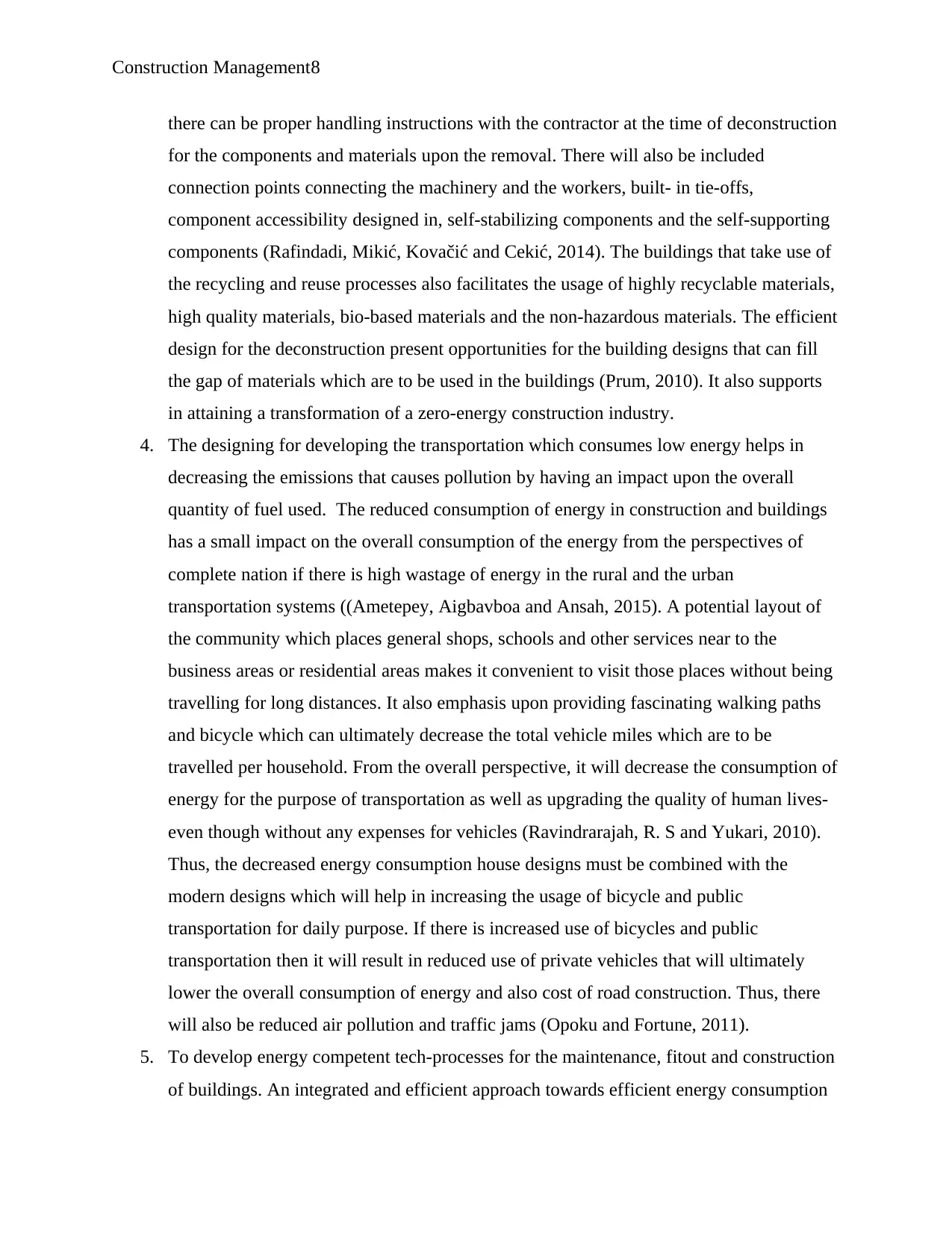
Construction Management8
there can be proper handling instructions with the contractor at the time of deconstruction
for the components and materials upon the removal. There will also be included
connection points connecting the machinery and the workers, built- in tie-offs,
component accessibility designed in, self-stabilizing components and the self-supporting
components (Rafindadi, Mikić, Kovačić and Cekić, 2014). The buildings that take use of
the recycling and reuse processes also facilitates the usage of highly recyclable materials,
high quality materials, bio-based materials and the non-hazardous materials. The efficient
design for the deconstruction present opportunities for the building designs that can fill
the gap of materials which are to be used in the buildings (Prum, 2010). It also supports
in attaining a transformation of a zero-energy construction industry.
4. The designing for developing the transportation which consumes low energy helps in
decreasing the emissions that causes pollution by having an impact upon the overall
quantity of fuel used. The reduced consumption of energy in construction and buildings
has a small impact on the overall consumption of the energy from the perspectives of
complete nation if there is high wastage of energy in the rural and the urban
transportation systems ((Ametepey, Aigbavboa and Ansah, 2015). A potential layout of
the community which places general shops, schools and other services near to the
business areas or residential areas makes it convenient to visit those places without being
travelling for long distances. It also emphasis upon providing fascinating walking paths
and bicycle which can ultimately decrease the total vehicle miles which are to be
travelled per household. From the overall perspective, it will decrease the consumption of
energy for the purpose of transportation as well as upgrading the quality of human lives-
even though without any expenses for vehicles (Ravindrarajah, R. S and Yukari, 2010).
Thus, the decreased energy consumption house designs must be combined with the
modern designs which will help in increasing the usage of bicycle and public
transportation for daily purpose. If there is increased use of bicycles and public
transportation then it will result in reduced use of private vehicles that will ultimately
lower the overall consumption of energy and also cost of road construction. Thus, there
will also be reduced air pollution and traffic jams (Opoku and Fortune, 2011).
5. To develop energy competent tech-processes for the maintenance, fitout and construction
of buildings. An integrated and efficient approach towards efficient energy consumption
there can be proper handling instructions with the contractor at the time of deconstruction
for the components and materials upon the removal. There will also be included
connection points connecting the machinery and the workers, built- in tie-offs,
component accessibility designed in, self-stabilizing components and the self-supporting
components (Rafindadi, Mikić, Kovačić and Cekić, 2014). The buildings that take use of
the recycling and reuse processes also facilitates the usage of highly recyclable materials,
high quality materials, bio-based materials and the non-hazardous materials. The efficient
design for the deconstruction present opportunities for the building designs that can fill
the gap of materials which are to be used in the buildings (Prum, 2010). It also supports
in attaining a transformation of a zero-energy construction industry.
4. The designing for developing the transportation which consumes low energy helps in
decreasing the emissions that causes pollution by having an impact upon the overall
quantity of fuel used. The reduced consumption of energy in construction and buildings
has a small impact on the overall consumption of the energy from the perspectives of
complete nation if there is high wastage of energy in the rural and the urban
transportation systems ((Ametepey, Aigbavboa and Ansah, 2015). A potential layout of
the community which places general shops, schools and other services near to the
business areas or residential areas makes it convenient to visit those places without being
travelling for long distances. It also emphasis upon providing fascinating walking paths
and bicycle which can ultimately decrease the total vehicle miles which are to be
travelled per household. From the overall perspective, it will decrease the consumption of
energy for the purpose of transportation as well as upgrading the quality of human lives-
even though without any expenses for vehicles (Ravindrarajah, R. S and Yukari, 2010).
Thus, the decreased energy consumption house designs must be combined with the
modern designs which will help in increasing the usage of bicycle and public
transportation for daily purpose. If there is increased use of bicycles and public
transportation then it will result in reduced use of private vehicles that will ultimately
lower the overall consumption of energy and also cost of road construction. Thus, there
will also be reduced air pollution and traffic jams (Opoku and Fortune, 2011).
5. To develop energy competent tech-processes for the maintenance, fitout and construction
of buildings. An integrated and efficient approach towards efficient energy consumption
⊘ This is a preview!⊘
Do you want full access?
Subscribe today to unlock all pages.

Trusted by 1+ million students worldwide
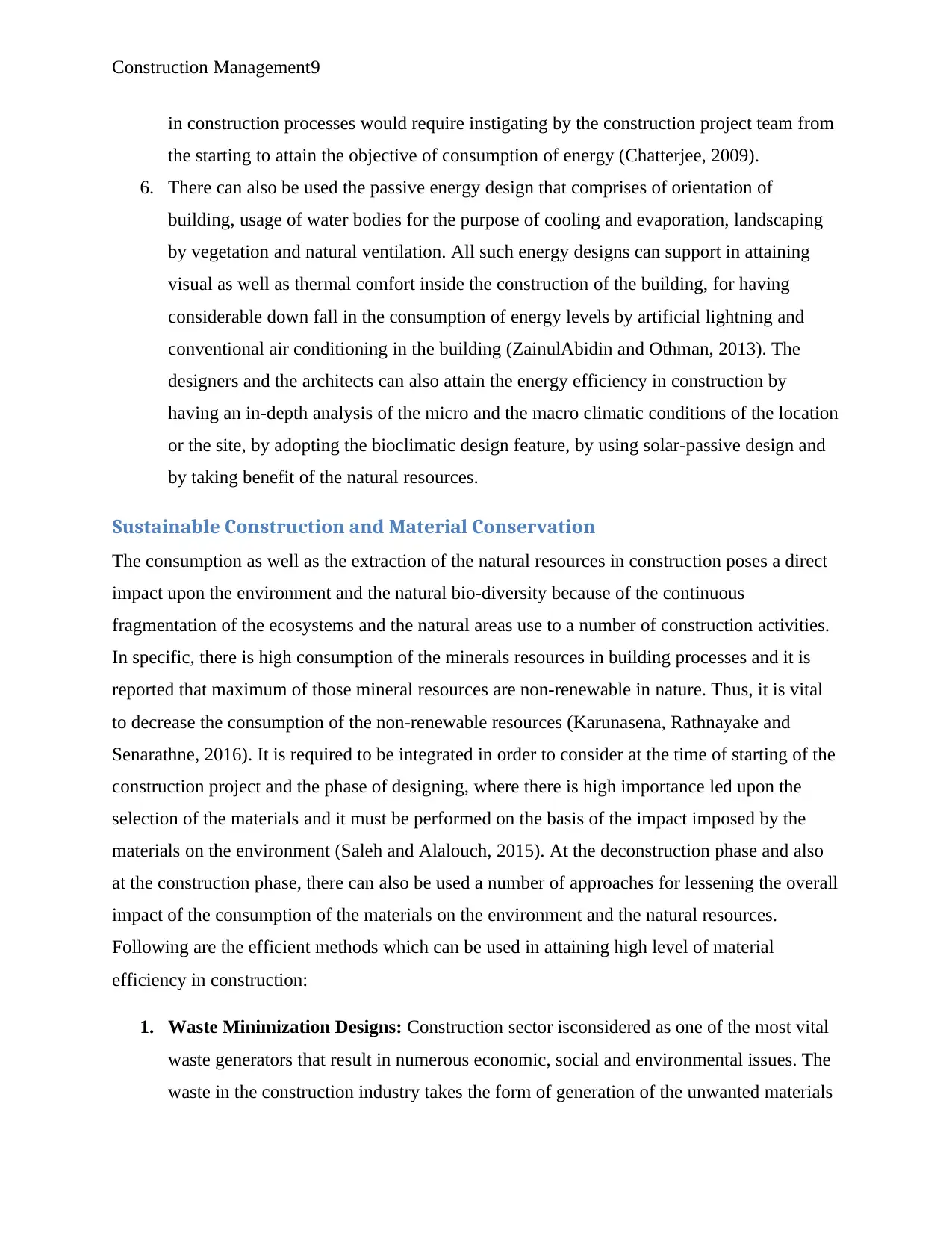
Construction Management9
in construction processes would require instigating by the construction project team from
the starting to attain the objective of consumption of energy (Chatterjee, 2009).
6. There can also be used the passive energy design that comprises of orientation of
building, usage of water bodies for the purpose of cooling and evaporation, landscaping
by vegetation and natural ventilation. All such energy designs can support in attaining
visual as well as thermal comfort inside the construction of the building, for having
considerable down fall in the consumption of energy levels by artificial lightning and
conventional air conditioning in the building (ZainulAbidin and Othman, 2013). The
designers and the architects can also attain the energy efficiency in construction by
having an in-depth analysis of the micro and the macro climatic conditions of the location
or the site, by adopting the bioclimatic design feature, by using solar-passive design and
by taking benefit of the natural resources.
Sustainable Construction and Material Conservation
The consumption as well as the extraction of the natural resources in construction poses a direct
impact upon the environment and the natural bio-diversity because of the continuous
fragmentation of the ecosystems and the natural areas use to a number of construction activities.
In specific, there is high consumption of the minerals resources in building processes and it is
reported that maximum of those mineral resources are non-renewable in nature. Thus, it is vital
to decrease the consumption of the non-renewable resources (Karunasena, Rathnayake and
Senarathne, 2016). It is required to be integrated in order to consider at the time of starting of the
construction project and the phase of designing, where there is high importance led upon the
selection of the materials and it must be performed on the basis of the impact imposed by the
materials on the environment (Saleh and Alalouch, 2015). At the deconstruction phase and also
at the construction phase, there can also be used a number of approaches for lessening the overall
impact of the consumption of the materials on the environment and the natural resources.
Following are the efficient methods which can be used in attaining high level of material
efficiency in construction:
1. Waste Minimization Designs: Construction sector isconsidered as one of the most vital
waste generators that result in numerous economic, social and environmental issues. The
waste in the construction industry takes the form of generation of the unwanted materials
in construction processes would require instigating by the construction project team from
the starting to attain the objective of consumption of energy (Chatterjee, 2009).
6. There can also be used the passive energy design that comprises of orientation of
building, usage of water bodies for the purpose of cooling and evaporation, landscaping
by vegetation and natural ventilation. All such energy designs can support in attaining
visual as well as thermal comfort inside the construction of the building, for having
considerable down fall in the consumption of energy levels by artificial lightning and
conventional air conditioning in the building (ZainulAbidin and Othman, 2013). The
designers and the architects can also attain the energy efficiency in construction by
having an in-depth analysis of the micro and the macro climatic conditions of the location
or the site, by adopting the bioclimatic design feature, by using solar-passive design and
by taking benefit of the natural resources.
Sustainable Construction and Material Conservation
The consumption as well as the extraction of the natural resources in construction poses a direct
impact upon the environment and the natural bio-diversity because of the continuous
fragmentation of the ecosystems and the natural areas use to a number of construction activities.
In specific, there is high consumption of the minerals resources in building processes and it is
reported that maximum of those mineral resources are non-renewable in nature. Thus, it is vital
to decrease the consumption of the non-renewable resources (Karunasena, Rathnayake and
Senarathne, 2016). It is required to be integrated in order to consider at the time of starting of the
construction project and the phase of designing, where there is high importance led upon the
selection of the materials and it must be performed on the basis of the impact imposed by the
materials on the environment (Saleh and Alalouch, 2015). At the deconstruction phase and also
at the construction phase, there can also be used a number of approaches for lessening the overall
impact of the consumption of the materials on the environment and the natural resources.
Following are the efficient methods which can be used in attaining high level of material
efficiency in construction:
1. Waste Minimization Designs: Construction sector isconsidered as one of the most vital
waste generators that result in numerous economic, social and environmental issues. The
waste in the construction industry takes the form of generation of the unwanted materials
Paraphrase This Document
Need a fresh take? Get an instant paraphrase of this document with our AI Paraphraser
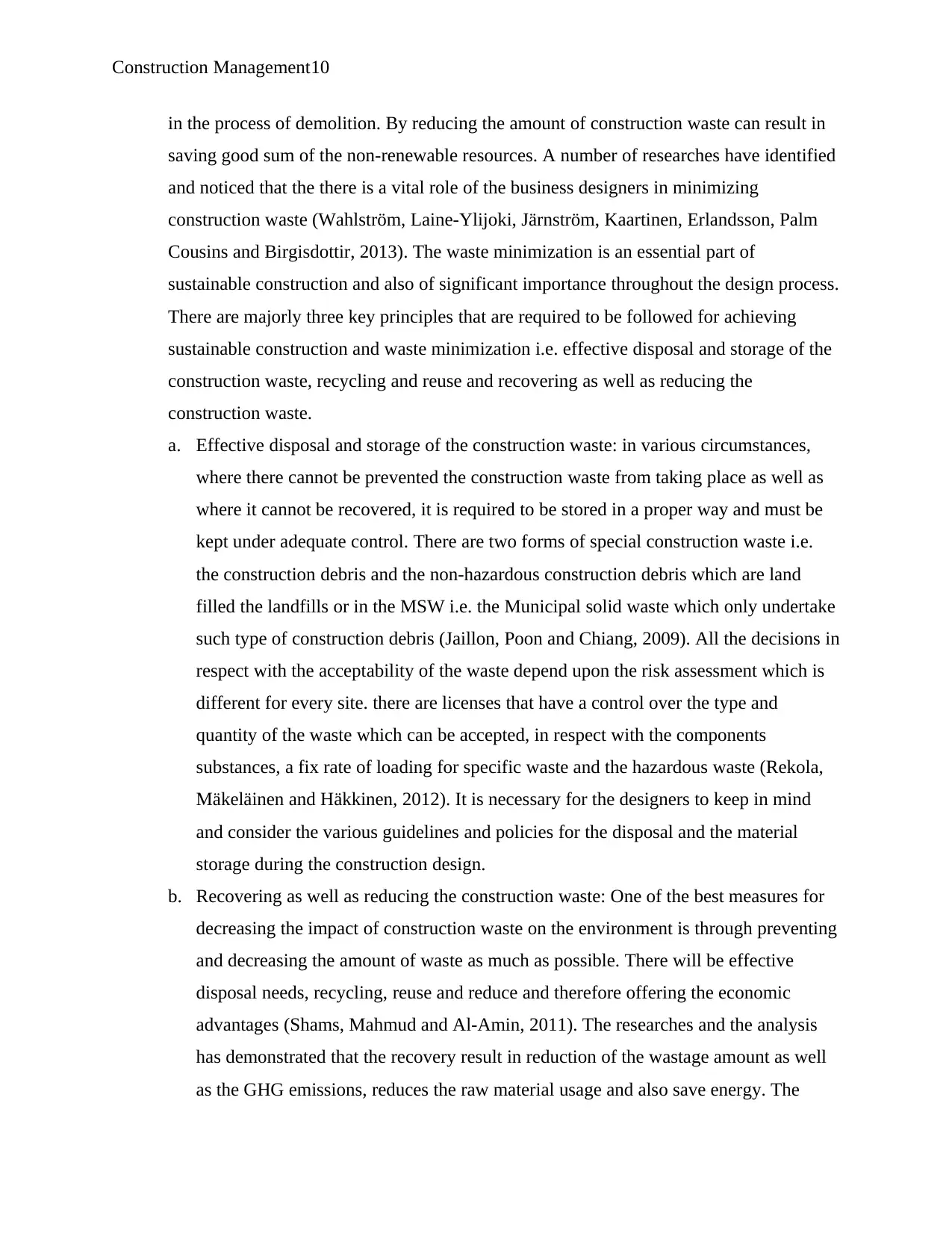
Construction Management10
in the process of demolition. By reducing the amount of construction waste can result in
saving good sum of the non-renewable resources. A number of researches have identified
and noticed that the there is a vital role of the business designers in minimizing
construction waste (Wahlström, Laine-Ylijoki, Järnström, Kaartinen, Erlandsson, Palm
Cousins and Birgisdottir, 2013). The waste minimization is an essential part of
sustainable construction and also of significant importance throughout the design process.
There are majorly three key principles that are required to be followed for achieving
sustainable construction and waste minimization i.e. effective disposal and storage of the
construction waste, recycling and reuse and recovering as well as reducing the
construction waste.
a. Effective disposal and storage of the construction waste: in various circumstances,
where there cannot be prevented the construction waste from taking place as well as
where it cannot be recovered, it is required to be stored in a proper way and must be
kept under adequate control. There are two forms of special construction waste i.e.
the construction debris and the non-hazardous construction debris which are land
filled the landfills or in the MSW i.e. the Municipal solid waste which only undertake
such type of construction debris (Jaillon, Poon and Chiang, 2009). All the decisions in
respect with the acceptability of the waste depend upon the risk assessment which is
different for every site. there are licenses that have a control over the type and
quantity of the waste which can be accepted, in respect with the components
substances, a fix rate of loading for specific waste and the hazardous waste (Rekola,
Mäkeläinen and Häkkinen, 2012). It is necessary for the designers to keep in mind
and consider the various guidelines and policies for the disposal and the material
storage during the construction design.
b. Recovering as well as reducing the construction waste: One of the best measures for
decreasing the impact of construction waste on the environment is through preventing
and decreasing the amount of waste as much as possible. There will be effective
disposal needs, recycling, reuse and reduce and therefore offering the economic
advantages (Shams, Mahmud and Al-Amin, 2011). The researches and the analysis
has demonstrated that the recovery result in reduction of the wastage amount as well
as the GHG emissions, reduces the raw material usage and also save energy. The
in the process of demolition. By reducing the amount of construction waste can result in
saving good sum of the non-renewable resources. A number of researches have identified
and noticed that the there is a vital role of the business designers in minimizing
construction waste (Wahlström, Laine-Ylijoki, Järnström, Kaartinen, Erlandsson, Palm
Cousins and Birgisdottir, 2013). The waste minimization is an essential part of
sustainable construction and also of significant importance throughout the design process.
There are majorly three key principles that are required to be followed for achieving
sustainable construction and waste minimization i.e. effective disposal and storage of the
construction waste, recycling and reuse and recovering as well as reducing the
construction waste.
a. Effective disposal and storage of the construction waste: in various circumstances,
where there cannot be prevented the construction waste from taking place as well as
where it cannot be recovered, it is required to be stored in a proper way and must be
kept under adequate control. There are two forms of special construction waste i.e.
the construction debris and the non-hazardous construction debris which are land
filled the landfills or in the MSW i.e. the Municipal solid waste which only undertake
such type of construction debris (Jaillon, Poon and Chiang, 2009). All the decisions in
respect with the acceptability of the waste depend upon the risk assessment which is
different for every site. there are licenses that have a control over the type and
quantity of the waste which can be accepted, in respect with the components
substances, a fix rate of loading for specific waste and the hazardous waste (Rekola,
Mäkeläinen and Häkkinen, 2012). It is necessary for the designers to keep in mind
and consider the various guidelines and policies for the disposal and the material
storage during the construction design.
b. Recovering as well as reducing the construction waste: One of the best measures for
decreasing the impact of construction waste on the environment is through preventing
and decreasing the amount of waste as much as possible. There will be effective
disposal needs, recycling, reuse and reduce and therefore offering the economic
advantages (Shams, Mahmud and Al-Amin, 2011). The researches and the analysis
has demonstrated that the recovery result in reduction of the wastage amount as well
as the GHG emissions, reduces the raw material usage and also save energy. The
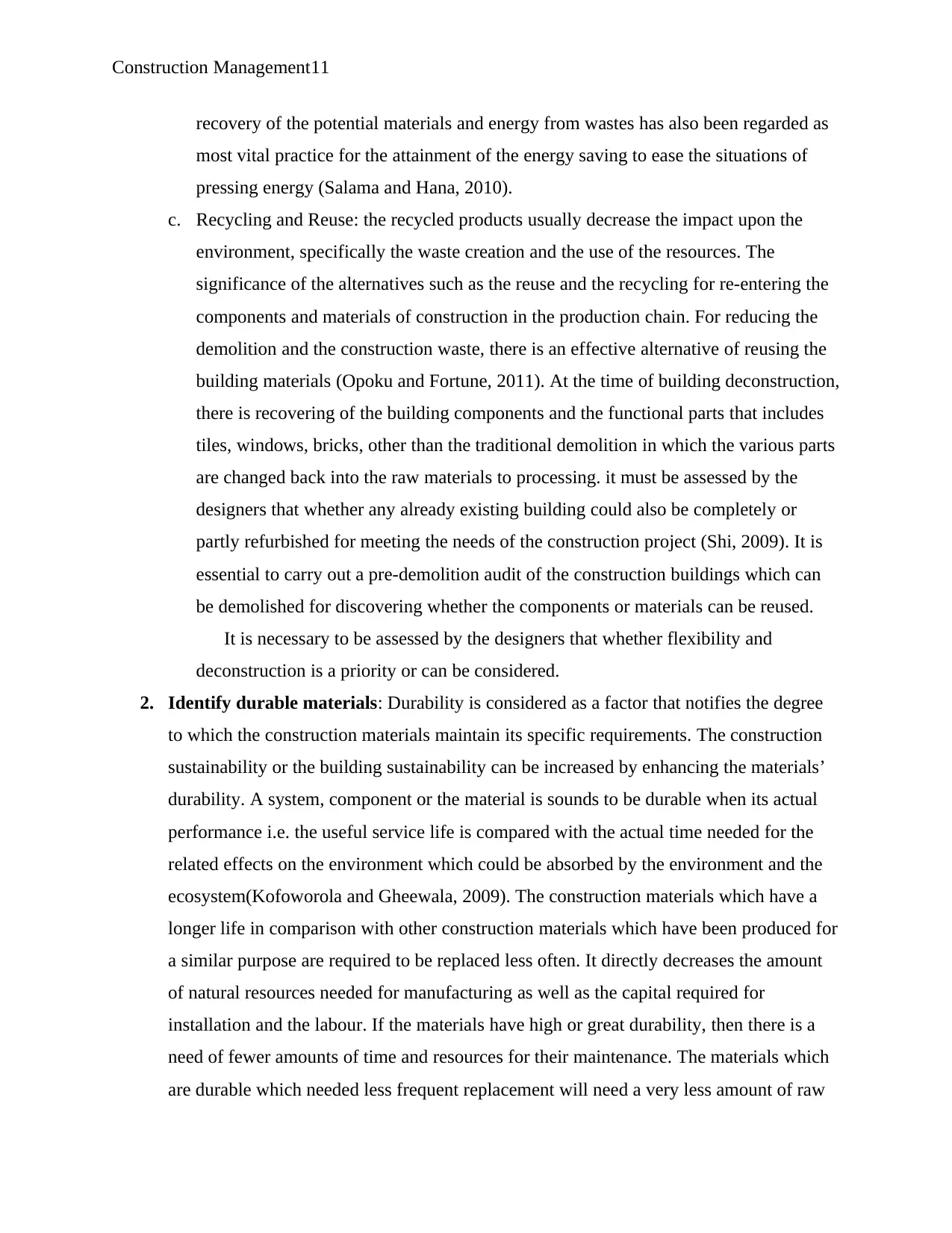
Construction Management11
recovery of the potential materials and energy from wastes has also been regarded as
most vital practice for the attainment of the energy saving to ease the situations of
pressing energy (Salama and Hana, 2010).
c. Recycling and Reuse: the recycled products usually decrease the impact upon the
environment, specifically the waste creation and the use of the resources. The
significance of the alternatives such as the reuse and the recycling for re-entering the
components and materials of construction in the production chain. For reducing the
demolition and the construction waste, there is an effective alternative of reusing the
building materials (Opoku and Fortune, 2011). At the time of building deconstruction,
there is recovering of the building components and the functional parts that includes
tiles, windows, bricks, other than the traditional demolition in which the various parts
are changed back into the raw materials to processing. it must be assessed by the
designers that whether any already existing building could also be completely or
partly refurbished for meeting the needs of the construction project (Shi, 2009). It is
essential to carry out a pre-demolition audit of the construction buildings which can
be demolished for discovering whether the components or materials can be reused.
It is necessary to be assessed by the designers that whether flexibility and
deconstruction is a priority or can be considered.
2. Identify durable materials: Durability is considered as a factor that notifies the degree
to which the construction materials maintain its specific requirements. The construction
sustainability or the building sustainability can be increased by enhancing the materials’
durability. A system, component or the material is sounds to be durable when its actual
performance i.e. the useful service life is compared with the actual time needed for the
related effects on the environment which could be absorbed by the environment and the
ecosystem(Kofoworola and Gheewala, 2009). The construction materials which have a
longer life in comparison with other construction materials which have been produced for
a similar purpose are required to be replaced less often. It directly decreases the amount
of natural resources needed for manufacturing as well as the capital required for
installation and the labour. If the materials have high or great durability, then there is a
need of fewer amounts of time and resources for their maintenance. The materials which
are durable which needed less frequent replacement will need a very less amount of raw
recovery of the potential materials and energy from wastes has also been regarded as
most vital practice for the attainment of the energy saving to ease the situations of
pressing energy (Salama and Hana, 2010).
c. Recycling and Reuse: the recycled products usually decrease the impact upon the
environment, specifically the waste creation and the use of the resources. The
significance of the alternatives such as the reuse and the recycling for re-entering the
components and materials of construction in the production chain. For reducing the
demolition and the construction waste, there is an effective alternative of reusing the
building materials (Opoku and Fortune, 2011). At the time of building deconstruction,
there is recovering of the building components and the functional parts that includes
tiles, windows, bricks, other than the traditional demolition in which the various parts
are changed back into the raw materials to processing. it must be assessed by the
designers that whether any already existing building could also be completely or
partly refurbished for meeting the needs of the construction project (Shi, 2009). It is
essential to carry out a pre-demolition audit of the construction buildings which can
be demolished for discovering whether the components or materials can be reused.
It is necessary to be assessed by the designers that whether flexibility and
deconstruction is a priority or can be considered.
2. Identify durable materials: Durability is considered as a factor that notifies the degree
to which the construction materials maintain its specific requirements. The construction
sustainability or the building sustainability can be increased by enhancing the materials’
durability. A system, component or the material is sounds to be durable when its actual
performance i.e. the useful service life is compared with the actual time needed for the
related effects on the environment which could be absorbed by the environment and the
ecosystem(Kofoworola and Gheewala, 2009). The construction materials which have a
longer life in comparison with other construction materials which have been produced for
a similar purpose are required to be replaced less often. It directly decreases the amount
of natural resources needed for manufacturing as well as the capital required for
installation and the labour. If the materials have high or great durability, then there is a
need of fewer amounts of time and resources for their maintenance. The materials which
are durable which needed less frequent replacement will need a very less amount of raw
⊘ This is a preview!⊘
Do you want full access?
Subscribe today to unlock all pages.

Trusted by 1+ million students worldwide
1 out of 31
Related Documents
Your All-in-One AI-Powered Toolkit for Academic Success.
+13062052269
info@desklib.com
Available 24*7 on WhatsApp / Email
![[object Object]](/_next/static/media/star-bottom.7253800d.svg)
Unlock your academic potential
Copyright © 2020–2025 A2Z Services. All Rights Reserved. Developed and managed by ZUCOL.





